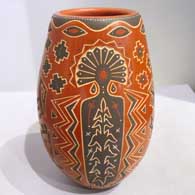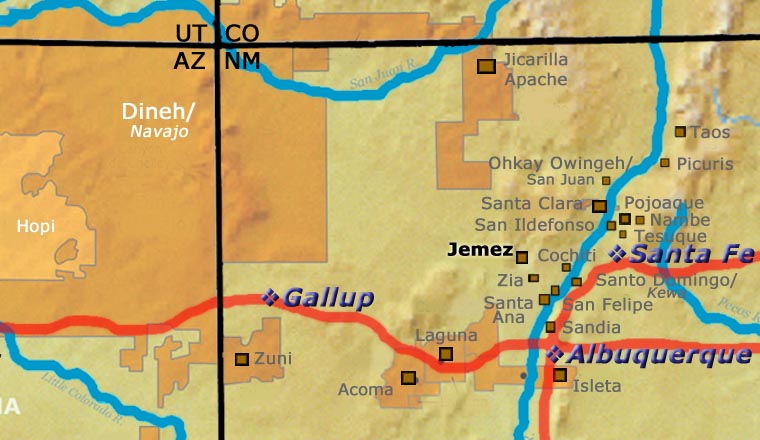
Glendora Fragua
Jemez
Born in St. Louis, Missouri in 1958, Glendora Fragua also spent some of her early years in California before her family returned to Jemez Pueblo in the 1970s. Her grandmother, Beninga Medina Madelena, married into Jemez Pueblo from Zia Pueblo years before and has been credited with helping to revive the Jemez pottery making tradition. Glendora learned the fundamentals of the traditional Jemez way of making pottery from her mother, Juanita Fragua, and by the age of 16 she was working with sgraffito techniques, working to develop her own style.
Glendora characterizes her work as contemporary/traditional: hand-gathered-and-processed clay, volcanic ash for temper, paints from the rocks and the plants, everything is done by hand the ancient way... her electric kiln is the only modern technology she uses. The designs she uses are her own, carved into her pots after they've dried and been polished but before firing. After carving she might add a red or buff or micaceous slip, then she adds her trademark cornstalk to the bottom and signs the piece before placing it in her kiln and firing it. Sometimes she adds inlaid stones to a piece, placing them, removing them before going in the kiln and then replacing them after the piece is finished being fired.
Glendora Daubs is a name many collectors recognize her by as she used that during the time she was married. Over the years she has earned pretty much every Blue Ribbon awarded for pottery at the various Indian Markets and Fairs in the Southwest at least once.
Some Awards Glendora has Earned
- 2020 Heard Museum Guild Indian Fair & Market, Classification II - Pottery, Division E - Any design or form with native materials, kiln-fired pottery: First Place. Awarded for the collaborative artwork with Juanita C. Fragua: "Generations"
- 2019 Heard Museum Guild Indian Fair & Market, Classification II - Pottery, Division G - Pottery miniatures not to exceed three (3) inches at its greatest dimension: Honorable Mention. Awarded for artwork: "Night Flight"
- 2016 Heard Museum Guild Indian Fair & Market: Best of Show. Awarded for the collaborative work with Jody Naranjo entitled: "Pueblo Luck"
- 2016 Heard Museum Guild Indian Fair & Market, Classification II - Pottery: Best of Classification. Awarded for the collaborative work with Jody Naranjo entitled: "Pueblo Luck"
- 2016 Heard Museum Guild Indian Fair & Market, Classification II - Pottery, Division A - Traditional, Native Clay, Hand Built, Painted: First Place. Awarded for the collaborative work with Jody Naranjo entitled: "Pueblo Luck"
- 2014 Heard Museum Guild Indian Fair & Market, Classification II Pottery, Division C - Traditional, native clay, hand built, carved: Second Place
- 2011 Heard Museum Guild Indian Fair & Market, Classification II - Pottery: Best of Classification with Harlan Reano
- 2011 Heard Museum Guild Indian Fair & Market, Classification II - Pottery, Division A - Traditional, native clay, hand built, painted: Honorable Mention
- 2007 Heard Museum Guild Indian Fair & Market, Classification II - Pottery, Division C - Traditional, native clay, hand built, carved: Second Place
100 West San Francisco Street, Santa Fe, New Mexico 87501
(505) 986-1234 - www.andreafisherpottery.com - All Rights Reserved

Jemez Pueblo

Ruins of San Jose de las Jemez Mission
As the drought in the Four Corners region deepened in the late 1200s, several clans of Towa-speaking people migrated southeastward from the Four Corners area to the Canyon de San Diego area the southern Jemez mountains, in what is now north-central New Mexico. Other clans of Towa-speaking people migrated southwest and settled in the Jeddito Wash area, below Antelope Mesa and southeast of Hopi First Mesa, in what is now northeastern Arizona. The migrations began in earnest in the mid 1200s and were mostly complete by the mid 1300s.
Archaeologist Jesse Walter Fewkes argues that potsherds found in the vicinity of the ruin at Sikyátki (near the foot of Hopi First Mesa) speak to the strong influence of earlier Towa-speaking potters on what became "Sikyátki Polychrome" pottery (Sikyátki was a village at the foot of First Mesa, destroyed before the first Hopi contact with the Spanish in 1540). Fewkes maintained that Sikyátki Polychrome pottery was the finest ceramic ware ever made in prehistoric North America.
Francisco de Coronado and his men arrived in the Jemez Mountains of Nuevo Mexico in 1539. By then the Jemez people had built several large masonry villages among the canyons and on some high ridges in the area. Their population was estimated at about 30,000 and they were among the largest and most powerful tribes in northern New Mexico. Some of their pueblos reached five stories high and contained as many as 3,000 rooms.
Because of the nature of the landscape they inhabited, growing food was very hard. So the Jemez became traders, too, and their people traded goods all over the Southwest and northern Mexico.
The arrival of the Spanish was disastrous for the Jemez and they resisted the Spanish with all their might. That led to many atrocities against the tribe until they rose up in the Pueblo Revolt of 1680 and evicted the Spanish from northern New Mexico. With the Spanish gone, the Jemez destroyed much of what they had built on Jemez land. Then they concentrated on preparing themselves for the eventual return of the hated priests and the Spanish military.
The Spanish returned in 1692 and their efforts to retake northern New Mexico bogged down as the Jemez fought them doggedly for four years. In 1696 many Jemez came together, killed a Franciscan missionary and then fled to join their distant relatives in the Jeddito Wash area. They remained at Jeddito Wash for several years before returning to the Jemez Mountains. As a result of that long ago contact, there are still strong ties between the Jemez and their cousins on Navajo territory at Jeddito. On their return to the Jemez Mountains, the people built the pueblo they now live in (Walatowa: The Place) and made peace with the Spanish authorities.
Some of the Jemez people had been making a type of plainware pottery (simple, undecorated, utilitarian) when they were still in the Four Corners area, while others had developed a distinctive type of black-on-white pottery. In moving to the Jemez Mountains, they brought their knowledge and techniques with them but had to adapt to the different materials available to work with. Over time, the Jemez got better in their agricultural practices and began trading agricultural goods to the people of Zia Pueblo in return for pottery. By the mid-1700s, the Jemez people were producing almost no pottery.
East of what is now Santa Fe is where the ruins of Cicuyé (Pecos) Pueblo are found. Cicuyé was a large pueblo housing up to 2,000 people at its height. The people of Cicuyé, and some in the northern Galisteo Basin, were the only other speakers of the Towa language in New Mexico. When that area fell on increasingly hard times (Apache and Comanche raids, European diseases, drought), Cicuyé was finally abandoned in 1838 when the last 17 residents moved to Jemez. The Governor of Jemez welcomed them and allowed them to retain many of their Cicuyé tribal offices (governorship and all). Descendants of former Cicuyé families still return to the site of their ancestral home every year to perform religious ceremonies in honor of their ancestors.
When general American interest in Puebloan pottery started to take off in the 1960s, the people of Jemez sought to recover that lost heritage. Today, the practice of traditional pottery-making is very much alive and well among the Jemez.
The focus of Jemez pottery today has mostly turned to the making of storytellers, nativities and other figures. Figures are an art form that now accounts for more than three-quarters of their pottery production.
Storytellers are usually grandparent figures with the figures of children attached to their bodies. The grandparents are pictured singing tribal songs and oral histories to their descendants. While this visual representation was first created at Cochiti Pueblo (a site in close geographical proximity to Jemez Pueblo) in the early 1960s by Helen Cordero, it speaks to the relationship between grandparents and grandchildren of every culture. Nativities, corn maidens, singing angels and many different animal forms are also popular among the potters of Jemez.
The pottery vessels made at Jemez Pueblo today are generally not black-on-white. Instead, the potters have adopted many colors, styles and techniques from other pueblos to the point where Jemez potters no longer have one distinct style of their own beyond that which stems naturally from the materials they themselves acquire from their surroundings: it doesn't matter what the shape or design is, the clay itself says uniquely "Jemez."
100 West San Francisco Street, Santa Fe, New Mexico 87501
(505) 986-1234 - www.andreafisherpottery.com - All Rights Reserved

Rita Casiquito Family Tree
Disclaimer: This "family tree" is a best effort on our part to determine who the potters are in this family and arrange them in a generational order. The general information available is questionable so we have tried to show each of these diagrams to living members of each family to get their input and approval, too. This diagram is subject to change should we get better info.
- Rita Casiquito Magdalena
- Juanita Fragua (1935-2023) and Manuel Fragua
- Betty Jean Fragua (1962-2022)
- Clifford Fragua
- Glendora Fragua Daubs (1958- )
- Geronima Shendo and Frank Shendo
- Roberta Shendo (1959- ) and Juan Chavez
- Helen Shendo (1955- )
Some of the above info is drawn from Southern Pueblo Pottery, 2000 Artist Biographies, by Gregory Schaaf, © 2002, Center for Indigenous Arts & Studies
Other info is derived from personal contacts with family members and through interminable searches of the Internet and cross-examination of the data found.
(505) 986-1234 - www.andreafisherpottery.com - All Rights Reserved
